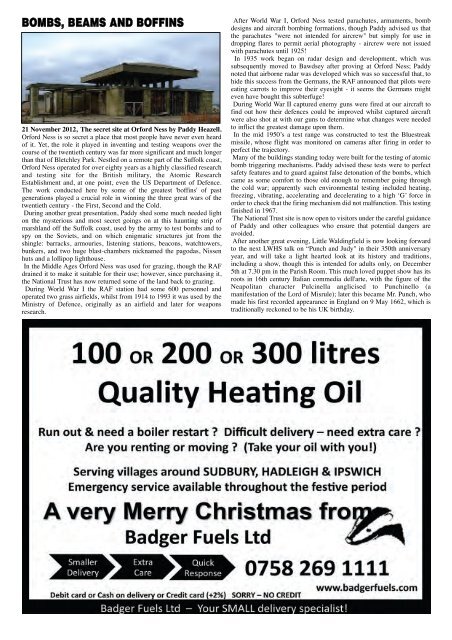BRN January 2013 colour - Boxford Community Council
BRN January 2013 colour - Boxford Community Council
BRN January 2013 colour - Boxford Community Council
Create successful ePaper yourself
Turn your PDF publications into a flip-book with our unique Google optimized e-Paper software.
BOMBS, BEAMS AND BOFFINS<br />
21 November 2012, The secret site at Orford Ness by Paddy Heazell.<br />
Orford Ness is so secret a place that most people have never even heard<br />
of it. Yet, the role it played in inventing and testing weapons over the<br />
course of the twentieth century was far more significant and much longer<br />
than that of Bletchley Park. Nestled on a remote part of the Suffolk coast,<br />
Orford Ness operated for over eighty years as a highly classified research<br />
and testing site for the British military, the Atomic Research<br />
Establishment and, at one point, even the US Department of Defence.<br />
The work conducted here by some of the greatest 'boffins' of past<br />
generations played a crucial role in winning the three great wars of the<br />
twentieth century - the First, Second and the Cold.<br />
During another great presentation, Paddy shed some much needed light<br />
on the mysterious and most secret goings on at this haunting strip of<br />
marshland off the Suffolk coast, used by the army to test bombs and to<br />
spy on the Soviets, and on which enigmatic structures jut from the<br />
shingle: barracks, armouries, listening stations, beacons, watchtowers,<br />
bunkers, and two huge blast-chambers nicknamed the pagodas, Nissen<br />
huts and a lollipop lighthouse.<br />
In the Middle Ages Orford Ness was used for grazing, though the RAF<br />
drained it to make it suitable for their use; however, since purchasing it,<br />
the National Trust has now returned some of the land back to grazing.<br />
During World War I the RAF station had some 600 personnel and<br />
operated two grass airfields, whilst from 1914 to 1993 it was used by the<br />
Ministry of Defence, originally as an airfield and later for weapons<br />
research.<br />
After World War I, Orford Ness tested parachutes, armaments, bomb<br />
designs and aircraft bombing formations, though Paddy advised us that<br />
the parachutes "were not intended for aircrew" but simply for use in<br />
dropping flares to permit aerial photography - aircrew were not issued<br />
with parachutes until 1925!<br />
In 1935 work began on radar design and development, which was<br />
subsequently moved to Bawdsey after proving at Orford Ness; Paddy<br />
noted that airborne radar was developed which was so successful that, to<br />
hide this success from the Germans, the RAF announced that pilots were<br />
eating carrots to improve their eyesight - it seems the Germans might<br />
even have bought this subterfuge!<br />
During World War II captured enemy guns were fired at our aircraft to<br />
find out how their defences could be improved whilst captured aircraft<br />
were also shot at with our guns to determine what changes were needed<br />
to inflict the greatest damage upon them.<br />
In the mid 1950’s a test range was constructed to test the Bluestreak<br />
missile, whose flight was monitored on cameras after firing in order to<br />
perfect the trajectory.<br />
Many of the buildings standing today were built for the testing of atomic<br />
bomb triggering mechanisms. Paddy advised these tests were to perfect<br />
safety features and to guard against false detonation of the bombs, which<br />
came as some comfort to those old enough to remember going through<br />
the cold war; apparently such environmental testing included heating,<br />
freezing, vibrating, accelerating and decelerating to a high ‘G’ force in<br />
order to check that the firing mechanism did not malfunction. This testing<br />
finished in 1967.<br />
The National Trust site is now open to visitors under the careful guidance<br />
of Paddy and other colleagues who ensure that potential dangers are<br />
avoided.<br />
After another great evening, Little Waldingfield is now looking forward<br />
to the next LWHS talk on “Punch and Judy" in their 350th anniversary<br />
year, and will take a light hearted look at its history and traditions,<br />
including a show, though this is intended for adults only, on December<br />
5th at 7.30 pm in the Parish Room. This much loved puppet show has its<br />
roots in 16th century Italian commedia dell'arte, with the figure of the<br />
Neapolitan character Pulcinella anglicised to Punchinello (a<br />
manifestation of the Lord of Misrule); later this became Mr. Punch, who<br />
made his first recorded appearance in England on 9 May 1662, which is<br />
traditionally reckoned to be his UK birthday.


